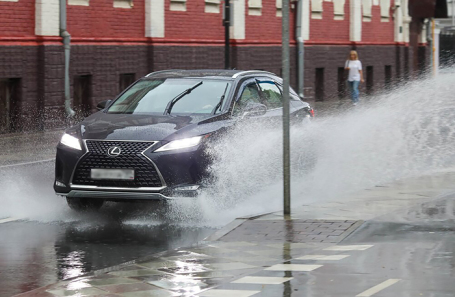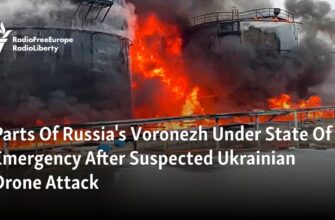Moscow, a city accustomed to the ebb and flow of its mighty river, recently faced an entirely different kind of aqueous challenge: an unprecedented downpour that transformed its bustling streets into rapid rivers. In less than two hours, some districts received a month`s worth of rainfall, leading to widespread flooding, traffic paralysis, and significant damage, particularly to vehicles. What began as a severe thunderstorm quickly escalated into an urban crisis, catching many off guard and putting the city`s infrastructure to the test.

The Deluge`s Immediate Impact
The intensity of the rainfall was staggering. Reports indicated that a full month`s precipitation fell in just a couple of hours in certain areas. This deluge quickly overwhelmed Moscow`s drainage systems, turning major thoroughfares like Dmitrovskoye Shosse and Krasovskiy Proezd into navigable waterways. Traffic came to a standstill, with countless cars becoming partially or fully submerged. Public transport also bore the brunt, with temporary closures on parts of the Arbatsko-Pokrovskaya metro line and the Bolshaya Koltsevaya Line (Rizhskaya station vestibule), as well as significant delays and cancellations for Aeroexpress trains serving Sheremetyevo Airport.
Voices from the Deluge: Personal Accounts of a Submerged City
As the waters rose, residents shared their astonishing experiences, painting a vivid picture of the chaos:
“Moscow is turning into Thailand,” quipped one commuter, Timofey, noting how water began seeping into his bus on Dmitrovskoye Shosse. He observed that many buses were simply not built for such “Thai weather,” causing them to leak.
Even outside the city center, the situation was dire. Pavel, spending time at his dacha in the Moscow region, described a scene of near-apocalyptic proportions:
“It`s been pouring since 11 AM here in Iksha, Dmitrovsky District. It started with a wild thunderstorm, thunder rumbling, the ground shaking, and then this insane downpour. It got as dark as evening, almost, and then the power went out for about two hours. Everywhere is flooded, you can`t even step onto the plot. I tried to drive to the station to the shop, but all the roads were submerged, cars crawling at about 10 kilometers per hour because of huge puddles.”
Visibility on the roads became a serious hazard. Vitaly, driving on Station Street in the city`s north, recounted a harrowing experience:
“There was about 5 centimeters of water on the road. Even at low speed, a fountain of spray would erupt from under the car, completely blinding you and oncoming traffic for a couple of seconds. Everyone was driving at 10 kilometers per hour – that`s where the traffic jams came from. The street drainage systems are completely overwhelmed. Something needs to be done, because any heavy rain turns Moscow into one big traffic jam.”
Indoor spaces offered little refuge. Elena, a shopper caught at a “Svetofor” store on Ilimskaya Street, witnessed the building`s struggle:
“Water immediately started flowing down the walls. The poor staff were frantically trying to save equipment, switch off electricity, and deal with the water on the floor. It was a serious flow. The little dip before the store entrance filled up in about 20 minutes. When I got to my car, the water was knee-deep. My car wasn`t driving; it was swimming. And now, the larger vehicles, the buses, they are truly floating, not driving. Staff say a manhole is blocked, that`s why the water isn`t draining.”
Amidst the chaos, daily life persisted, albeit humorously. Ilya, a student, found himself in a particularly damp predicament:
“Today, July 15th, is not just the day when almost 50% of the monthly rainfall norm occurred, but also the day the spring conscription ends. And I`m currently on my way to the military enlistment office to hand in documents. For me, these two events coinciding was a most unpleasant circumstance. My sneakers are absolutely soaked, and I think I`ve wet my documents – my diploma is in there, my student certificate. Life is full of unpleasant surprises.”
The Automotive Aftermath: “Car Graveyards” and Recovery Advice
The most visually striking consequence of the flood was the sight of numerous submerged vehicles, leading some areas to be dubbed “car graveyards.” On Prospekt Mira, residential streets vanished under water, leaving parked cars half-submerged. For those whose vehicles were caught in the deluge, automotive expert Artyom Bobtsov offered critical advice:
“Under no circumstances should you start a flooded car,” Bobtsov warned. “Doing so risks a hydraulic lock, which can completely destroy the engine. The car needs to be loaded onto a tow truck, or if inaccessible, a manipulator crane, and taken to a specialized service center.”
The primary concern, he explained, is the electronic systems. “Water causes short circuits in electronic control units, leading to widespread electrical failure. In modern vehicles, this can be fatal or, at the very least, extremely costly and time-consuming to repair.”
The recovery process involves meticulous drying: “They open all electronic blocks, blow out all possible cavities in the engine, and expose all body cavities, including under seats and in the trunk, because water constantly accumulates under floor mats and will never drain on its own, causing the car to rot within six months.”
Such comprehensive restoration typically takes three to four days, but with the high volume of affected vehicles, timelines could extend. Bobtsov estimated costs ranging from 100,000 to 200,000 rubles ($1,000-$2,000 USD), cautioning vehicle owners to call around for quotes due to the unstandardized nature of such repairs.
For prevention, he stressed, “Always park your car on elevated ground.” If encountering deep puddles, “do so with extreme caution, or better yet, simply go around. It’s better to park further away from home or work and walk a bit than to deal with such an unpleasant and costly ordeal.”
For vehicles still only partially affected, moving them to dry ground is advisable, and photographic documentation of damage is crucial for insurance claims.
Navigating the New Normal: Mobility and Warnings
The flood also impacted other urban mobility services. Ride-hailing apps like Yandex Go saw prices surge by two to three times due to high demand and limited vehicle availability. Food delivery services, like Yandex Eda, reported delays, citing “labyrinths of puddles” as a significant impediment.
Kick-sharing services issued their own advisories. While scooters might operate in the rain, companies like Whoosh and MTS Urent warned against riding through deep puddles, emphasizing the need for caution despite sealed batteries and electronics. Yandex Go suggested postponing scooter trips entirely in bad weather.
Emergency services issued urgent warnings for residents: drivers were advised to drastically reduce speed, increase following distances, and avoid sudden maneuvers. Pedestrians were cautioned to steer clear of advertising hoardings, unstable structures, and to avoid seeking shelter under trees.
The Meteorological Outlook: A Soggy Week Ahead
According to meteorologist Aleksey Safonov from Meteoweb, the extreme weather was far from over. The city was braced for continued showers, thunderstorms, and even hail, with wind gusts expected to reach 19-23 meters per second and an intensity of 20 liters of rainwater per square meter. While temperatures would become more “comfortable” at 23-25 degrees Celsius, the relentless precipitation was set to persist throughout the week.
The recent deluge serves as a stark reminder of the escalating challenges posed by extreme weather events in urban environments. Moscow`s battle against the rising waters highlights the critical need for robust infrastructure, effective emergency responses, and perhaps, a re-evaluation of what constitutes `normal` weather in a changing climate. For now, Muscovites are advised to keep their umbrellas close and their vehicles well above the waterline, as the city adapts to its new, wetter reality.









